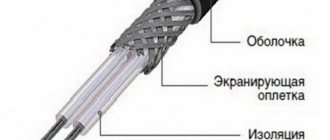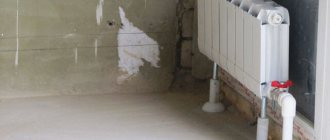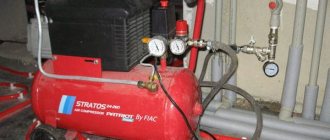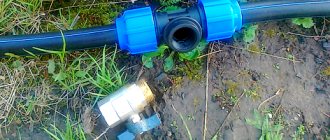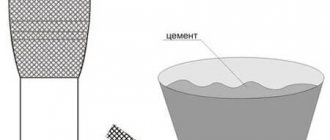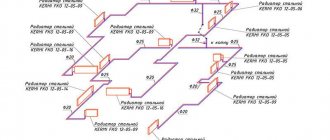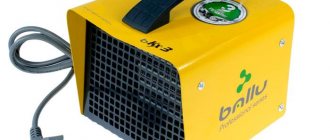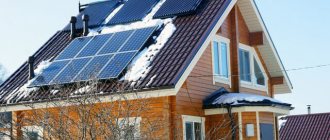Connection diagrams
What schemes can be used:
Instantaneous water heater
A scheme using a flow-through heater involves heating water in a specially designated tank or device at a time when water passes through it under pressure.
There are a huge variety of ways to provide flow-through heating by using:
- geyser;
- electric flow heater;
- water supply systems with heating system;
- double-circuit boiler.
In each case, one principle is involved - instant heating of water from heating elements. To make the water hot enough, it is necessary to install very powerful electrical devices or consume a large amount of gas, otherwise the water at the outlet will not reach an acceptable temperature.
The same applies to the number of water distribution points; for example, taking a shower and washing dishes at the same time will be difficult, since not every device can heat a large amount of water at once.
Storage heater
The second method is to install a water heating tank . Cold water flows into it, after which it is heated by the built-in heating element to a specified level. Such a water heating system is superior in price, but guarantees uninterrupted access to water until it runs out in the tank.
The user can choose the tank volume at his own discretion, based on his needs.
You can find two versions of such tanks on sale: with indirect heating and layered. Stratified tanks are also often used in conjunction with instantaneous heaters, while indirect tanks are a completely autonomous water heating system.
Heating pipes at the entrance to the house
Heating the pipe at the entrance to the house with a heating cable
Question: Is it possible to heat the pipe only at the entrance to the house? That is, will a heating cable help in this situation:
- A summer version of the house was originally built. But later it was decided to refurbish the house so that people could come there
in late autumn or winter, for example, on weekends. During construction, the pipe to the house was laid to the freezing depth. But the pipe at the exit from the blind area to the entrance to the house is in the freezing zone. Therefore, most likely, this area will freeze in winter. Is it possible to solve this problem if a self-regulating heating cable is installed on this section? HDPE pipe, black, Ø32.
Answer : Provided that you need to warm up the pipe in the fall, that is, when the temperature is not too low and if the pipe “sticks” only in a narrow area in front of the entrance to the house, then it is quite enough to tightly attach a heating cable for the water supply to it, secure it with aluminum tape and put on insulation. To use the water supply, upon arrival at the house you will simply need to turn on the heating of the pipe.
If you plan to stay in the house in winter, then such heating will most likely not be enough - the water supply will freeze. Although this depends on various factors. For example, if the pipe is located below the freezing point of the soil or the quality of the soil is so dense, then the pipe does not freeze even in severe frosts. Then it will be possible to get by with heating the pipe in a small area at the entrance to the house.
If the soil is loose, the pipe may freeze, especially during prolonged cold weather. As a rule, this happens towards the end of winter. It will thaw no earlier than the end of April or the beginning of May, when the ground at depth has warmed up sufficiently. In this case, in order to heat the water supply system, it is necessary to install a heating cable inside the pipe.
Question:
- What to do if the pipe is buried and its edge is laid in a blind area. Accordingly, it is not possible to insert a self-regulating heating cable inside?
Answer: If the pipeline is not tightly poured into the foundation (blind area) and there is a small space next to the heated pipe, then you can use a self-regulating heating cable of higher power (40W). You need to lay it (squeeze it) as close to the pipe as possible. This often helps solve the problem of freezing - by heating the space adjacent to the pipe, the cable can defrost the water supply system. It is important here that there are “no drafts”, and the self-regulating heating cable would be able to heat the space in the place where it does not fit tightly to the heated pipe.
But such a solution can only be considered as a temporary option. If in the future you plan to spend the winter in a summer house or come to severe frosts, then the pipeline is dug up and heated with an external heating cable, or an internal one:
- attach an external heating cable to the heated pipe and put on insulation along its entire length
- insert the heating cable into the pipe.
This will allow the pipeline to be heated even where the pipes are not buried deep enough.
If it is not possible to dig up the pipe, then you can try the following option: clear a small gap near the pipe, where you can insert a heating cable of higher power.
Question: If it is possible to install a heating cable both inside the pipe and outside on the water supply, then which option is better to choose?
Answer: If you have access to the pipe, then it is better to place the heating cable outside the pipe - it is more reliable (fewer tees, sealing glands for introducing the heating cable inside the pipe, couplings for connection), simpler and cheaper. It is advisable to run the cable inside the pipe if it is not possible to lay the thermal cable outside. Depending on the need, a household or food heating cable can be used.
You might be interested in:
- Heating of pipes It is recommended to carry out heating of pipes and protection against freezing of main pipelines on the basis of reliable self-regulating cables. We offer Heatus heating systems…
- Heating pipes with a heating cable The task of heating pipes or, in other words, protection against freezing is familiar to those who live or operate pipelines in a climate zone where the temperature ...
- Heating of water pipes over 60 mm To protect water pipes with a diameter of 60 mm and more from freezing, a self-regulating heating cable with a rated power of 30…
- Heating pipes with a cable - from the outside, from the inside, water supply, sewerage: what can be done The purpose of this article is to clarify what heating problems can be solved using a self-regulating heating cable, and with an emphasis on...
What to choose for the home and what for the dacha?
Using a running hot water supply system in a residential building is impractical for many reasons. Water consumption in houses where people live permanently differs markedly from consumption in country houses, especially if not just one person lives, but a family.
The flow system is fraught with a number of disadvantages for users:
Reduced hot water pressure due to limiters built into heating equipment.- Unpredictable changes in tap water temperature.
- Waiting for water to flow after opening the tap.
- High consumption of electricity or gas, depending on the type of system chosen.
However, for a summer residence, a flow system will be the optimal solution. After all, the need for hot water is not so high, the cost of such a system is much lower, and its dimensions are more compact.
There is also another important advantage - if when using a water heating tank you need to wait for water after turning on the equipment, then users of flow-through systems are free of this problem.
A flow system is better for a summer residence, the use of water heating tanks is better for a home , but there are exceptions. For example, when one person lives in a house or when people live in a dacha not occasionally, but permanently. Therefore, each case must be considered separately.
Effective protection against freezing of communications
The depth of the wells is several tens of meters, so they never freeze completely. Already at a depth of a meter (or more) the temperature does not drop below zero. Therefore, a self-regulating heating cable must be installed only at the very base and in pipes that are close to the surface.
Communications for water supply are always laid at a depth of 0.5 meters or more. This is a guarantee that the system will not freeze at sub-zero temperatures. But the pipes located above and the base of the well must be heated. For this purpose, cables are used that can change the temperature depending on external conditions.
Unlike conventional thermal insulation materials, electrical systems are more effective at preventing the formation of ice. This is possible due to the fact that uniform heating occurs throughout the entire area located at the level of soil freezing or on the surface.
Did you know?
The peculiarity of self-regulating thermal cables lies precisely in their ability to change temperature. This allows you to save on electricity. The thermostat reacts almost instantly to external temperature changes, switching the operating mode of the heating cable.
How to equip a hot water supply using a storage water heating tank?
There are two types of water heating tanks: stratified and indirect. An indirect tank is a metal tank with a heating element inside.
The structure of the heating element is designed in such a way that it heats the entire volume of the tank evenly. Layer-type models are designed in a similar way, the only difference is that the element is located on one side, and hot water is collected at one wall, and cold water at the other.
Most often, layer-by-layer models are installed as an addition to double-circuit boilers . If the tank is needed as the only source of hot water, then it is better, of course, to give preference to models with indirect heating.
Boiler with layer heating
It is best to place such a tank in close proximity to the boiler. Also, during installation, it is worth considering the condition of the walls, because most users prefer to mount this equipment on walls, not taking into account that the weight of an empty tank is already 20-30 kg, and when it is filled with water, it will become much heavier, and not every wall can withstand similar load.
Installation instructions:
Decide on the installation location, taking into account that the boiler with layer-by-layer heating must be located between the boiler and the consumer.- Either fix the tank to the wall using special brackets, or install it on the floor.
- The connection between the boiler and the water tap must be cut.
- Using couplings, connect the boiler to the boiler, and use the outlet elbow as a pipe for consumption (DHW disassembly).
- Remove the return current from the boiler to the boiler to drain cold water in a similar way. Install a check valve at the connection point.
- Connect the equipment to the electrical network.
It is worth considering that the heating element of the boiler is sensitive to scale and various types of sediment contained in the water, especially if hard water from wells or individual wells is used.
Therefore, experts recommend installing a special mesh filter , or, in the best case, full-fledged filters for hard water, then the equipment will last much longer.
Indirect heating boiler
An indirectly heated boiler is used as a stand-alone equipment without any auxiliary hot water systems.
It is worth taking into account the same feature as that of a layered boiler - the total weight, in addition, it is worth strictly following the manufacturer's instructions: some models require strictly vertical installation, others - strictly horizontal.
Installation instructions:
Install the boiler according to the instructions (horizontally or vertically), or attach it to the wall using brackets.- Make a cut at the inlet of the cold water system and install a tee at the cut site. One outlet will serve as a carrier of cold water, the other - hot.
- The remaining pipe (HVS) is inserted into the tee, and a new one is also soldered.
- The new pipe is brought to the boiler and connected using couplings (the method of fastening may vary depending on the specific model).
- In the same way, a second pipe is attached to the boiler, which is distributed to the hot water supply points.
- The tank is connected to the electrical network.
Most models of such equipment have quite high power, so it is recommended to connect to an individual line protected by automatic protection.
Self-regulating heating wire - a modern solution
A cable with a temperature self-regulation function is the most convenient option for heating the water supply in a private home in winter. No complex automation is required for control - the wire independently regulates the heating power. The price of the heating cable is affordable for the average consumer, and installation is quick and does not require specific equipment. The special properties of the product are due to the use of a semiconductor matrix, which changes energy consumption depending on the ambient temperature.
How to organize hot water through a heat exchanger?
To organize a hot water supply system, several types of heat exchange devices are used, but their essence boils down to one thing - to create a circuit that will transfer heat from a heating source (for example, the same furnace or boiler) to the water supply system. Therefore, it will be impossible to clearly describe the installation instructions; everything depends only on the selected type of device.
But the general approach for installing a heat exchanger will be as follows:
- Install the heat exchanger near or inside the selected heat source. This could be a boiler, a heating stove, a chimney, or a heating radiator.
- A cut is made on the cold water inlet pipe and a tee is installed. In the case of a DHW heat exchanger, only metal pipes can be used!
- Connect one of the pipes to the heat exchanger, and remove the second pipe from its outlet, which will become the source of hot water distribution.
There is a fundamental difference between cast iron, copper, steel and stainless steel heat exchangers that is worth considering.
How to ensure a stable water supply
As you know, you should prepare for cold weather in advance; the ideal option is if the premises were initially built with year-round living in mind, but even a wealthy person would not heat an empty dacha for several months. It is much easier to adapt designs to start and stop quickly.
Water supply from a well.
A few words about pipes
Pipes are now produced to suit every taste and budget, but winter water supply at the dacha has its own nuances.
- Thus, polyethylene water supply is suitable for organizing irrigation in summer and only if water is used up to 40 ºС.
- Polyvinyl chloride is not suitable for country cottages, as it is afraid of ultraviolet radiation.
- Copper water supply made from annealed material is close to ideal, it can last up to 100 years and when the moisture inside freezes, it does not crack, but only deforms. But the price of such a system will be exorbitant, plus in unguarded dachas copper can simply be stolen.
Soldering polypropylene.
- According to the unanimous opinion of experts, the best option for water supply to a country house is to install a system made of polypropylene. Due to their good elasticity, when freezing, pipes for country water supply only stretch. Hot water is also not a hindrance for them, they are designed for -15 - +95 ºС, their price is quite reasonable and most importantly, such structures can be assembled with your own hands, all you need is scissors and a soldering iron.
Polypropylene line.
Winter pipe heating system
Often in country cottages, water enters the house from a well or borehole. Most often, these sources are located at some distance and the pipe leading into the house may freeze during cold weather.
Any instruction states that it is advisable to install the pipeline below the freezing point. But this is not always possible, since in some areas this point can be deeper than 2m.
Nowadays, it is customary to use a special heating cable to heat water supply or sewer systems. Instructions for installing such heating may vary; more precisely, there are 2 different approaches to this problem. Let's start with the fact that such a line can be placed at any depth. Moreover, there are open wiring options.
Important: any water supply line is made with a slope of at least 20 mm per 1 linear meter in relation to the source of water intake. If this source is located above the building itself, then a drain valve is installed in the basement to ensure the drainage of water in the dacha for the winter.
Water pipeline slope diagram.
The first method is suitable for those who install the system with their own hands. In this case, the heating electric cable is attached directly to the pipeline. It can be placed in one line, several lines, or in a spiral.
The second method is more universal. It can be used both for newly installed structures and for purchased dachas with a ready-made water supply system. Its essence is that the heating element is placed inside the pipeline. There is no need to attach it, but you will need an adapter for inserting into the system and a special waterproof cable.
Heating cable installation diagram.
What types of cables are there?
- The legacy system is a closed loop. The length and resistance are clearly defined in it, it cannot be shortened and the contours should not intersect with each other, plus it is advisable to equip a separate thermostat.
- The second option is more progressive; the wire consists of two conductive cores, between which there is a self-regulating polymer heater. This cable does not require a thermostat. The characteristics of the polymer are such that it begins to heat only when the temperature drops, therefore, the lines can intersect. And most importantly, you can use any length.
Insulation of water supply.
Important: no matter what method you choose, the pipes should be insulated. This can be foamed polyethylene, foamed rubber or any other insulation. Insulation is especially important for shallow and open lines.
The average power consumption of such a cable is approximately 30W per 1 p/m. Modern polymer cables are more economical, but their price is higher. Some dacha communities lose power during the winter, and renting a diesel generator for a dacha can easily save the situation, because such units are designed for a much larger load.
System Maintenance
No matter how ideally the DHW system is installed, no matter what type it is, it needs regular maintenance.
The frequency depends on many factors:
- selected type of system,
- equipment,
- the presence of filtering devices,
- water quality in the cold water system.
With instantaneous water heater
Maintenance of gas equipment is reduced to annual:
- washing built-in heat exchangers with a special solution,
- cleaning the turbine, gas filter, combustion chamber,
- checking the health of the electrical circuit,
- adjusting the pressure in the expansion tank.
These procedures cannot be performed independently; this is the prerogative of gas supply service specialists. Moreover, if a seal is installed, then it must not be torn off under any circumstances - this may result in a protocol on an administrative violation.
As for electric heaters, it’s simpler here . It is enough to replace the heating elements as they fail with new ones. You can do this yourself.
With storage water heater
Maintenance of storage heating tanks does not require regular intervention in the operation of the equipment. It is enough to inspect the heating elements every two to three years, if they are open - cleaning them, washing them with an acid-containing solution, as well as washing the inside of the tank itself.
These procedures cannot be called complicated, but not every user can properly disassemble the tank, much less reassemble it, so if the slightest doubt arises, it is better to immediately entrust this work to specialists.
Possible problems
What problems may you encounter:
With instantaneous water heater
Each chosen method of providing a home with hot water has its own weaknesses.
Electric flow heaters often fail due to burnout of heating elements , which become covered with scale and cannot withstand the load.
The same applies to the heat exchanger - poor water quality clogs the coil or honeycomb, which leads to excess pressure, and possibly even rupture and leakage of the equipment.
Therefore, maintenance consists of organizing proper filtration of the hot water supply, replacing heating elements and ensuring correct connection from an electrical point of view.
High power electrical appliances must be equipped with individual electrical protective equipment . As for geysers and boilers, they need periodic cleaning of excess combustion products.
With storage water heater
The main problems remain the same - the performance of the heating elements, the quality of the incoming water and electrical safety.
It is electrical safety that many users neglect, not realizing that this is not only protection against electric shock, but protection of the most expensive equipment.
All models of storage heating tanks are made of metal, which means that without proper grounding, they are subject to accelerated corrosion. If the tank leaks, then in most cases, such equipment cannot be repaired. This is why it is so important to check the ground circuit .
As for heating elements, in these models they are even more susceptible to burnout than in flow-through ones.
Everything you need to know about hot water is presented in this section of the site.

